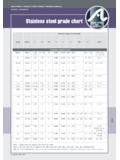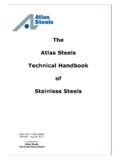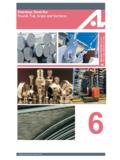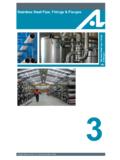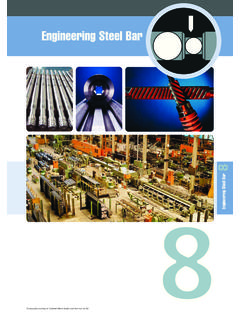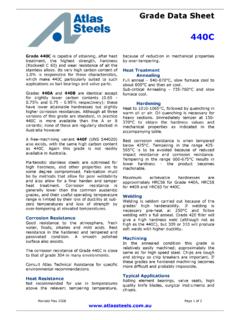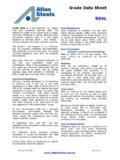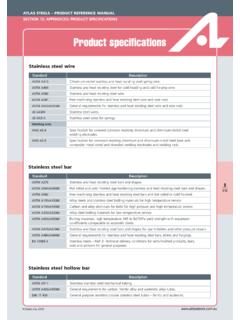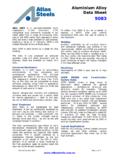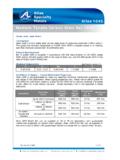Transcription of The Atlas Steels Technical Handbook of Stainless Steels
1 TheAtlas SteelsTechnical HandbookofStainless SteelsCopyright Atlas SteelsRevised : August 2013 Produced byAtlas SteelsTechnical DepartmentATLAS Steels Technical Handbook of Stainless SteelsPage Technical Handbook has been produced as an aid to all personnel of Atlas Steels , their customers and theengineering community generally. It is intended to be both background reading for Technical seminars conductedby Atlas Steels Technical Department, and also as a source of ongoing reference data. Any suggestions forimprovements, additions or corrections would be very welcome; these should be directed to: Technical Manager, Atlas SteelsTelephone +61 3 8383 9863, of this Handbook can be downloaded from the Atlas Steels web site of specific products are given in the Atlas Steels Product Reference Manual , the series of Atlas GradeData Sheets and in Atlas Technotes, as listed below.
2 Copies of all these can be viewed or downloaded from theAtlas Steels Steels Sorting Tests for & Crevice Corrosion of Stainless Steels - Properties & Equivalent of Stainless , Care & Maintenance of Stainless Cycle Corrosion8."L", "H" and Standard Grades of Stainless steel Tube for the Food of Hazardous Substances (RoHS) Response of Stainless Dimensions13. AtlasCR12 & AtlasCR12Ti the 12% Chromium Ferritic Stainless Alloys 5052 and 5251 Quite Similar but Completely DifferentAtlas grade DatasheetsConcise datasheets, covering all the common Stainless Steels , include chemical composition, mechanical andphysical properties, fabrication and application of each grade .
3 Again these are available from the AtlasSteels from any Atlas publications can be freely copied, but it is requested that the source Steels Technical DepartmentAtlas Steels Technical Department comprises experienced metallurgists, based at our Melbourne Head offer a free information service, including: Metal grade selection Fabrication information Special Steels applications Specification assistance (such as equivalents of foreign specifications and trade names) Metallurgical properties of metals Supply of Technical literature published by Atlas Steels and other metals institutions and also have our own metallurgical laboratory providing facilities to assist in investigation of products assistance is provided as a free service to Atlas Steels ' valued customers, and to all members of theAustralian and New Zealand engineering of LiabilityThe information contained in this Technical Handbook is not an exhaustive statement of all relevant information.
4 Itis a general guide for customers to the products and services available from Atlas Steels and no representation ismade or warranty given in relation to this information or the products or processes it by Atlas Steels Technical DepartmentCopyright Atlas SteelsATLAS Steels Technical Handbook of Stainless SteelsPage OF CONTENTSFOREWORD2 Atlas Steels Technotes2 Atlas grade Datasheets2 Atlas Steels Technical Department2 Limitation of Liability2 TABLE OF CONTENTS3 THE FAMILY OF MATERIALS4 steel grade Designations4 Stainless Steels - INTRODUCTION TOTHE GRADES AND FAMILIES6 The Families of Stainless Steels6 Austenitic Stainless Steels6 Ferritic Stainless Steels7 Martensitic Stainless Steels7 Duplex Stainless Steels7 Precipitation Hardening Stainless Steels 7 Characteristics of Stainless Steels7 Standard Classifications7 Austenitic and Duplex Stainless Steels8 Ferritic and Martensitic Stainless Steels9 Comparative Properties of the Stainless SteelAlloy Families10 CORROSION RESISTANCE11 General Corrosion11 Pitting corrosion11 Crevice corrosion12 Stress corrosion
5 Cracking (SCC)12 Sulphide Stress Corrosion Cracking (SSC) 13 Intergranular corrosion13 Galvanic corrosion14 Contact corrosion14 HIGH TEMPERATURE RESISTANCE16 Scaling Resistance16 Creep Strength16 Structural Stability17 Environmental Factors17 Thermal Expansion17 CRYOGENIC PROPERTIES19 MAGNETIC PROPERTIES20 Magnetically Soft Stainless Steels20 MECHANICAL PROPERTIES21 Mechanical Properties of Wire22 Mechanical Properties of Bar22 FABRICATION23 Forming Operations23 Machining25 Welding26 Soft Soldering27 Brazing ("Silver Soldering")27 HEAT TREATMENT29 Annealing29 Hardening30 Stress Relieving30 Surface Hardening31 SURFACE FINISHING32 Passivation32 Pickling32 Degreasing33 Electropolishing33 Grinding and Polishing33 Mechanical Cleaning34 Blackening34 SURFACE CONTAMINATION INFABRICATION35 Contamination by Carbon Steel35 Contamination by Chlorides35 Contamination by Carbon35 DESIGN CONSIDERATIONS INFABRICATION OF Stainless STEELS36 grade Selection for Fabrication36 Design to Avoid Corrosion36 Specific Design Points - To Retain CorrosionResistance37 GUIDELINES FOR
6 Stainless steel GRADESELECTION39 APPENDICES41 grade Summary - Stainless & Heat ResistingSteels41 Comparison of grade Specifications ofStainless Steels43 Typical Physical Properties - AnnealedCondition44 Hardness Conversions45 Unit Conversions46 Dimensional Tolerances for Bar47 Further Information48 Internet Sites of Interest49 Atlas Steels Technical Handbook of Stainless SteelsPage FAMILY OF MATERIALSM aterials can be divided into metals and non-metals; the history of civilisation has largely beencategorised by the ability to work metals - hence"bronze age" and "iron age" - but until quiterecently most large-scale construction was still innon-metals, mostly stone or masonry and a vast number of materials compete fortheir share of the market, with more newmaterials being added every year.
7 Someparticularly exciting developments are nowoccurring in the fields of ceramics, plastics andglasses and composites of these materials. Theday of the ceramic car engine is probably not allthat far off - already there are some hightemperature components made from the newgeneration of tougher ceramics, and the modernmotor vehicle also offers many examples of theuse of engineering plastics. Recent developmentsin metals have re-asserted their competitiveposition in auto engineering, in particular the useof aluminium and magnesium alloys.
8 A majorrevolution under way at present is thereplacement of much copper telecommunicationscabling with glass optical fibre. For metals tocompete they must be able to demonstratesuperior properties to their a similar fashion each of the metals has tocompete for its market share, based ondemonstrated superiority of properties oreconomics. It is therefore worth identifying thevarious metals available and indicating just whattheir most important features are. A basicdifferentiation is to divide metals into "ferrous"and "non-ferrous", ie those iron-based and all the non-ferrousmetals the mostimportant for engineering applications are thefamilies of aluminium alloys (with very lowdensities, high electrical and thermal conductivity,good formability and good corrosion resistancethese find applications in aircraft, high tensionelectricity conductors, yacht masts etc)
9 And ofcopper alloys (with very high electrical andthermal conductivities and ready formability thesefind their principal applications in electrical wiring).Other important non-ferrous alloys (an alloy issimply a mixture of two or more metals) are thebrasses and family of ferrousmetals incorporates a vastnumber of alloys. Those alloys containing a veryhigh proportion of carbon (over about 2%) arecalled cast irons. Virtually all of the remainder aretermed Steels and these can be found in eithercast form (produced by pouring molten metal intoa mould of the shape of the finished part) orwrought form (cast as ingots or continuous castbillets or slabs, but then hot rolled or forged toproduce bars, plates or complex shapes such asrail sections and beams).
10 They can also be formedto finished shape by sintering powdered metal athigh temperature. Steels are categorised by theirmajor alloying elements (carbon, manganese,chromium, nickel and molybdenum) and by th
